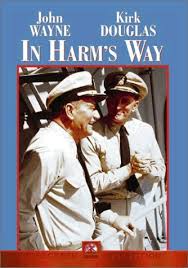
Paths of Glory was forbidden in the UK and in Switzerland until the 70s. French troops disturbed the opening in West Berlin. The movie was forbidden in American cinemas for soldiers. It was forbidden in France during the war in Algeria. It was shown in Paris for the first time in 1975. What’s that telling us? That this is a radical anti-war statement that openly criticizes high command. It is powerful and thought-provoking and absolutely unambiguous as to its goal. I felt a bit uneasy that Kubrick chose to criticize French command. Didn’t he have plenty of opportunities to criticize American command? Be it as it may, Paths of Glory, which is based on a true account, is a great achievement.
The movie opens with the Marseillaise and a voice telling the horrors of WWI, the numbers of soldiers that get killed daily to no avail. The incident on which the movie centers took place in 1916 in France. The movie moves back and forth between the trenches and the high command residing in an elegant Château.
An ambitious general asks of the equally ambitious general Mireau to take a hill, held by German troops, the so-called “Ant Hill”. A highly symbolical name if there ever was one as people are treated no better than ants and wiped out with one simple gesture. When general Mireau informs colonel Dax (Kirk Douglas) of the order to attack the ant-hill, he is met with incredulity. Dax tells him that it is impossible and will cost an incredible amount of lives. The answer is a sarcastic calculation. 65% of the men will not survive and the outcome is not even sure. Dax wants to refuse the order but is threatened to be replaced.
The futility of the attack becomes obvious right away. Dax fights in the front line with his men who die one after the other. He and many others retreat after seeing that they can’t make it. Many stayed in the trenches, knowing damn well they would be killed and nothing could be won. Seeing the men’s reluctance to run into certain death, general Mireau orders to open fire on them but the officer who receives the order refuses.
The frustrated general then orders a court-martial. Three men are chosen in lieu of all the others and accused of cowardice. Colonel Dax, a lawyer in civilian life, takes up their defence. Like the court-martial in Breaker Morant, this is a pure sham.
Kubrick’s movie has a lot of interesting elements. Colonel Dax is one of the great war movie characters. A officer of high moral standards, free of carrerism and ambition, a just and human being. Kirk Douglas was very well-chosen for this role. He is very believable and gives a great performance.
The contrasts between the high command who is far from the action and thinks they can mock simple soldiers who are afraid, slap those who show signs of shell-shock and judge others that refuse to run into certain death, is fantastic. Paths of Glory is one of those movies that has scenes that will stay with you forever because they are emotionally true and powerful. The utter cynicism of the high command, the way they calculate losses without giving further thought to the fact that each number equals a human being, will make you cringe.
It is a movie that belongs to two sub-categories. The court-martial movies like Breaker Morant and the “Taking a hill movies” like Hamburger Hill, Pork Chop Hill, Gallipoli and The Thin Red Line.
Apparently there is a more recent French TV film Le Pantalon (1996) that quotes Paths of Glory in its major parts.
As much good as I may have said, I had my reservations. I did not understand the use of black and white. The movie doesn’t work so well from a cinematographic point of view. There are not so many contrasts and shadows as there normally are in black and white movies. Even Pork Chop Hill (far less good as a whole) looks much better. Kubrick is famous for the use of colours in his movies… I don’t see it as entirely logical that he didn’t shoot this in color. But that is the only flaw I could find. It still deserves a solid 4.5/5.
